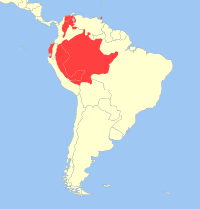White-fronted capuchin
| White-fronted capuchin | |
|---|---|
 |
|
| Scientific classification | |
| Kingdom: | Animalia |
| Phylum: | Chordata |
| Class: | Mammalia |
| Order: | Primates |
| Family: | Cebidae |
| Genus: | Cebus |
| Species: | C. albifrons |
| Binomial name | |
|
Cebus albifrons (Humboldt, 1812) |
|
 |
|
| Geographic range in South America | |
The white-fronted capuchin (Cebus albifrons) is a species of capuchin monkey, a type of New World primate, found in seven different countries in South America: Bolivia, Brazil, Colombia, Venezuela, Ecuador, Peru, and Trinidad and Tobago. The species is divided into several different subspecies, though the specific divisions are uncertain and controversial.
This primate is a medium-sized monkey with a light brown back and a creamy white underside. Like other capuchin monkeys, it is omnivorous, feeding primarily on fruits, invertebrates, other plant parts and sometimes small vertebrates. It is predated upon primarily by raptors and probably small cats, especially the margay, though snakes have been known to attack the species. It is a polygamous animal and lives on fairly large groups of 15 to 35 individuals, reproductive females give birth to a single young at biennial intervals. The species maintains a home range of 1.2 to 1.5 km2 (0.46 to 0.58 sq mi) and has a complex vocal repertoire. It is one of the few primates to have been observed crafting and utilising tools in the wild.
White-fronted capuchin populations are declining. The decline is believed to be caused by human-induced habitat loss and degradation, and hunting. In 2008 the International Union for Conservation of Nature (IUCN) classified the Ecuadorian white-fronted capuchin (ssp. aequatorialis) and the Trinidad white-fronted capuchin (ssp. trinitatis) as critically endangered, and the varied white-fronted capuchin (ssp. versicolor) in Colombia is classified as endangered. The total population of the Trinidad subspecies was 61 at the last census.
...
Wikipedia

